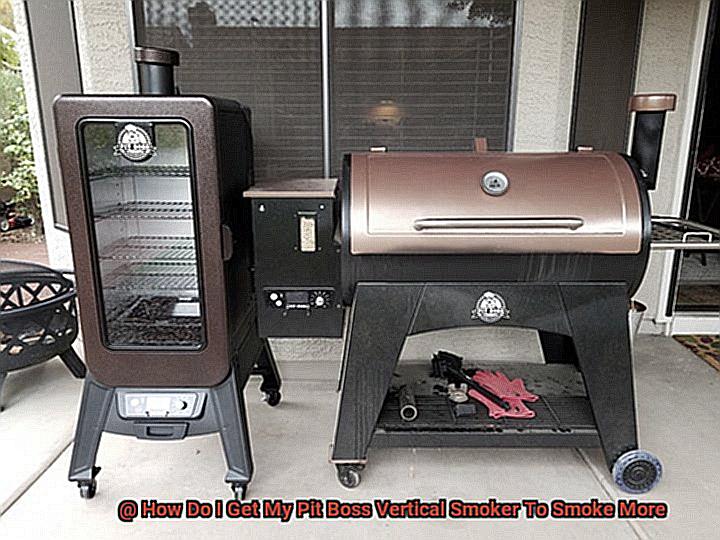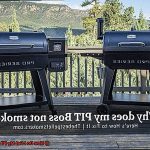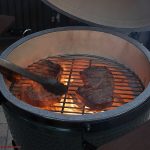Are you tired of your Pit Boss vertical smoker not delivering that smoky flavor you crave for your meats? You’re not alone in this struggle. Many smoking enthusiasts have faced the same issue. But don’t worry, there are several solutions to get more smoke from your Pit Boss vertical smoker.
Before we delve into the solutions, let’s understand why smoke is so important. Smoke not only adds a delicious flavor to your meats, but it also acts as a natural preservative and helps prevent harmful bacteria growth during the cooking process.
So, how can you increase the amount of smoke from your Pit Boss vertical smoker? There are several things you can do to achieve this, such as using wood chunks instead of chips or adjusting the temperature and air flow. Keeping the temperature low and vent closed can lead to an intense smoke flavor that will make your taste buds dance with joy.
In this post, we’ll explore these tips and more in detail to help you master the art of smoking with your Pit Boss vertical smoker. Get ready to fire up the smoker and create mouth-watering, flavorful meats that will impress everyone at your next barbecue.
Contents
Ensure Adequate Fuel Supply
If you’re a Pit Boss vertical smoker aficionado, then you know that the ultimate goal is to achieve the perfect smoky flavor. And to do that, you must ensure that your smoker has an adequate fuel supply. So, how do you ensure that your smoker is well-fueled? Let’s dive deeper into some helpful tips.
Firstly, it’s important to know what type of fuel source you’re using. The most commonly used fuels include wood pellets, charcoal, and wood chips. For wood pellet users, make sure to keep the hopper full at all times. This is where the pellets are stored before they are fed into the firepot. Running out of pellets will cause your smoker to stop smoking and the temperature will decrease. Therefore, always fill up the hopper before starting your smoker and monitor it throughout the cooking process.
For charcoal users, ensure that there is enough charcoal in the firebox to maintain a consistent temperature. Start by evenly covering the bottom of the box with enough charcoal. Add more charcoal as needed throughout the cooking process to maintain a consistent temperature and smoke output.
Wood chips are also a popular fuel source for smokers. To maximize their effectiveness, soak them in water for at least 30 minutes before using them. This will prevent them from burning too quickly and producing too much heat. Place the soaked wood chips in a smoker box or aluminum foil pouch with holes poked in it and place it on top of the hot coals or heating element.
In addition to fuel sources, adjusting air intake and exhaust dampers can increase smoke output. Partially closing the exhaust damper allows more smoke to build up inside the smoker before it escapes. Similarly, opening the air intake damper wider increases oxygen and fuel intake, resulting in more smoke.
Lastly, keeping your Pit Boss vertical smoker clean and well-maintained is crucial to its performance. A dirty or clogged smoker can disrupt airflow and prevent smoke from circulating properly. Clean out any ash or debris from previous smoking sessions and check for any leaks or damage that could be affecting its performance.
Soak Wood Chips or Pellets
The question of whether to soak your wood chips or pellets is a common one among pitmasters, and you may be wondering what the best approach is. Well, it’s not a simple answer, but we’re here to break it down for you.
Let’s start by examining the theory behind soaking wood. Soaking is believed to produce more smoke and flavor by creating steam from the water in the wood, which mixes with the smoke and infuses the meat. Sounds tempting, right?
However, there are some potential downsides to consider. One of the main concerns is that wet wood takes longer to ignite and produce smoke, which can cause temperature fluctuations in your smoker. This could make it difficult to maintain consistent temperatures and potentially impact the quality of your meat. Additionally, soaked wood can also create more creosote buildup in your smoker, which can be harmful to both you and your equipment.
But fear not, there are still benefits to soaking your wood if you’re willing to take on these risks. Here are some key points to consider:
- Soaked wood can produce stronger smoke flavors that some pitmasters prefer.
- Soaking can prolong the burn time of your wood chips or pellets.
- If you’re using a smaller smoker or grill, soaking may be necessary to prevent your wood from burning up too quickly.
On the other hand, if you prioritize consistency and efficiency in your smoking process, then it may be best to skip the soaking step altogether. Drier wood will ignite faster and produce smoke more consistently, which can result in a smoother smoking experience overall.
To sum it up, whether or not to soak your wood chips or pellets depends on your personal preference and smoking goals. If you want that extra kick of flavor and don’t mind taking on potential risks, go ahead and soak away. But if you prioritize consistency and efficiency, then skip the soaking and let your dry wood do the talking.
Adjust Air Intake and Exhaust Dampers
These dampers regulate the airflow inside the smoker, which directly affects smoke production.
First, let’s talk about the air intake damper. It’s located at the bottom of the smoker and allows oxygen to enter the unit. To get more smoke, open it up all the way. But be careful not to let too much oxygen in, or you’ll end up with bitter-tasting food. Finding that perfect balance is key to achieving optimal smoking conditions.
Next up is the exhaust damper, located at the top of your smoker. This damper controls how much smoke escapes from the unit. To increase smoke production, partially close the exhaust damper. By doing so, less smoke will escape, causing it to circulate inside your smoker for longer. The result? A more intense smoky flavor that will have your taste buds dancing with joy.

But don’t forget about keeping your smoker clean. Removing any debris or ash buildup can significantly improve airflow and smoke production. So, before starting a new smoking session, make sure to clean out any leftover ash or residue from previous ones.
Use Different Types of Woods
If you’re a barbecue enthusiast looking to take your grilling experience to the next level, then using different types of woods in your Pit Boss vertical smoker is a must-try. Each wood type creates a unique flavor profile that can make your grilled food stand out from the crowd.
Understanding the Importance of Using Different Types of Woods
Using different types of woods in your Pit Boss vertical smoker is essential to enhance the smoking experience. Different woods produce different flavors and intensities of smoke, making it crucial to choose the right combination to achieve the desired taste.
Choosing the Right Type of Wood
When selecting wood for smoking, you should pick hardwoods that are free from chemicals and contaminants that may affect your food’s taste. Popular hardwoods for smoking are hickory, oak, mesquite, cherry, apple, and pecan.
Hickory produces a strong smoky flavor, ideal for red meats like brisket and ribs. Mesquite offers a robust flavor great for grilling steak or roasting vegetables. Oak produces mild smoke perfect for beef, pork, and poultry. Cherry has a sweet fruity flavor that pairs well with pork and poultry. Applewood produces light sweet smoke ideal for chicken or fish. Pecan has a nutty sweet flavor perfect for turkey or ham.
Finding the Right Balance
The size of the wood chips also plays an important role in the smoking process. Larger wood pieces burn slowly and produce more smoke, while smaller ones burn faster and produce less smoke. Finding the right balance between size and amount of smoke is essential to achieve your desired flavor.
Experimenting with Different Types of Woods
Experimentation is key to finding the perfect combination of woods that best suits your taste buds. Try using a blend of hardwoods and fruitwoods like apple, cherry, and peach to create a unique and complex flavor profile. You can also try using exotic woods like mesquite or pecan to add a new twist to your smoked meats.
Tips for Using Different Types of Woods in Your Pit Boss Vertical Smoker
To use different types of woods on your Pit Boss vertical smoker, you need to purchase wood chips or chunks specific to the type of wood you want to use. Soak the wood chips in water for at least 30 minutes before using them in your smoker to prevent them from burning too quickly and producing too much smoke.
Keep the Smoker Clean and Well-Maintained
You’re on your way to mastering the art of smoking and creating mouthwatering, smoky flavors that will amaze your guests. But before you take on that next barbecue challenge, it’s essential to know how to keep your smoker clean and well-maintained.
To ensure maximum smoke efficiency, your smoker must be kept clean and in good working order. A dirty smoker can lead to unsafe cooking conditions, uneven heating, and less smoke production. With these tips, you’ll be able to keep your Pit Boss vertical smoker in tip-top shape.
Regular Cleaning
The first step in maintaining your smoker is regular cleaning. After each use, remove any remaining ash or debris from the smoker’s firebox and grates. Use a brush or scraper to get rid of any stubborn residue. Then, wipe down the interior of the smoker with a damp cloth or sponge.
It’s also crucial to keep the smoker’s vents clean. Blocked vents can restrict airflow, leading to less smoke production. Use a small brush or toothbrush to remove any build-up around the vents.
Routine Maintenance
Along with regular cleaning, performing routine maintenance on your smoker is crucial. Check the seals around the door of the smoker and replace them if necessary. Damaged seals can cause heat loss and reduce smoke production.
Another important factor is checking the temperature gauge for accuracy. If it’s inaccurate, you may need to recalibrate or replace it to ensure precise temperature control.
Using High-Quality Wood Pellets or Chips
The type of wood pellets or chips you use can also affect your smoker’s performance. Choosing high-quality wood ensures maximum smoke production and prevents any unwanted flavors from affecting your food.
Final Thoughts
Monitor Temperature and Smoke Output Regularly
Achieving the perfect smoke flavor is an art form, and it all starts with monitoring the temperature and smoke output regularly.
Maintaining a consistent temperature range of 225°F to 275°F is key in achieving the ideal balance of cooking and smoking. To ensure that your meat cooks evenly and has a delicious smoky taste, use a digital or analog thermometer to monitor the temperature accurately. Place the thermometer probe at the center of the cooking grate away from any direct heat source, and adjust the air vents or add more fuel as needed.
But temperature isn’t the only factor to consider when it comes to smoking meats. Smoke output is just as important in creating that delicious smoky flavor. Thin blue smoke is what you want, while thick white smoke indicates that your wood chips are not combusting correctly and can result in an unpleasant taste.
To achieve thin blue smoke, make sure your wood chips are dry and not soaking wet. Soaking them can cause thick white smoke instead of thin blue smoke. Additionally, adding wood chips gradually and consistently throughout the smoking process can increase smoke output without causing sudden spikes in temperature.
In summary, monitoring temperature and smoke output regularly is crucial for achieving perfectly smoked meats every time. Follow these tips to achieve that ideal balance of cooking and smoking, resulting in delectable flavors that will make your mouth water:
- Maintain a consistent temperature range
- Use a thermometer to monitor the temperature accurately
- Adjust the air vents or add more fuel as needed
- Ensure your wood chips are dry
- Add wood chips gradually and consistently throughout the smoking process
Experiment with Different Smoking Techniques
Then it’s time to experiment with different smoking techniques on your Pit Boss vertical smoker. With so many options available, it may take some trial and error to find the perfect combination that suits your palate. Here are some tips to get you started:
The first technique to try is using different types of wood chips or chunks. The type of wood used can make a significant difference in the flavor of your smoked dishes. Hickory is known for its strong, smoky taste, while fruitwoods like apple or cherry can add a sweet note. Why not experiment with a few different varieties and see which one you prefer?
Adjusting the temperature and airflow within the smoker is another technique to play around with. The temperature can affect the amount of smoke produced, so finding the right balance is crucial. Additionally, adjusting airflow can help regulate the circulation of smoke within the smoker.
Consider the placement of your food within the smoker. Placing your food towards the back of the smoker exposes it to more smoke than towards the front. This can result in a more even distribution of smoke and enhance the overall flavor.
Finally, don’t be afraid to experiment with different smoking times. Longer smoking times can result in a more intense smoky flavor, but it’s important to monitor it closely to prevent overcooking and dryness.
Invest in Quality Accessories for Your Pit Boss Vertical Smoker
Look no further than investing in quality accessories. As an expert on this matter, I can guarantee that the right accessories will make a world of difference in your smoking experience.
First and foremost, let’s talk about the heart of your smoker: the smoker box. This small but mighty accessory sits on top of the burner and holds wood chips or pellets, infusing your food with that delicious smoky flavor. To ensure optimal performance, choose a high-quality smoker box made from durable materials like stainless steel. And don’t forget about size – opt for one that’s large enough to hold a decent amount of wood chips or pellets, so you don’t have to keep refilling it during long smoking sessions.
Next up is the digital thermometer. This game-changing accessory allows you to monitor the temperature inside your smoker with greater accuracy, ensuring that your food cooks evenly and doesn’t dry out or burn. Look for a thermometer with a large, easy-to-read display and a probe that can be inserted directly into your meat for precise readings.
In addition to these must-have accessories, consider investing in a drip tray to catch any excess juices or grease, which can then be used to make flavorful sauces or gravies. And don’t forget about a cover to protect your smoker from the elements when it’s not in use.
Lastly, don’t skimp on high-quality smoking wood chips or pellets. Trust me; they make all the difference. Opt for options that will give your food a rich, smoky flavor without any harsh or bitter aftertaste.
L_TAnDSFX30″ >
Conclusion
In summary, achieving that perfect smoky flavor from your Pit Boss vertical smoker is within reach with the right techniques and accessories.
Smoke not only adds delicious flavor to your meats but also acts as a natural preservative, making it a must-have for any smoking enthusiast. To ensure optimal fuel supply, try using wood pellets, charcoal or wood chips while adjusting the air intake and exhaust dampers to increase smoke output.
Soaking your chosen wood chips or pellets can also enhance the smoke flavors, but finding the ideal balance between size and amount of smoke is crucial. Consistently monitoring temperature and smoke output will help you achieve perfectly smoked meats every time.
You can take your grilling experience up a notch by experimenting with different smoking techniques like trying out various types of woods, adjusting temperature and airflow within the smoker, considering food placement within the smoker, and testing different smoking times.






